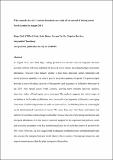Files in this item
Who controls the city? A micro-historical case study of the spread of rioting across North London in August 2011
Item metadata
| dc.contributor.author | Ball, Roger | |
| dc.contributor.author | Stott, Clifford | |
| dc.contributor.author | Drury, John | |
| dc.contributor.author | Neville, Fergus Gilmour | |
| dc.contributor.author | Reicher, Stephen David | |
| dc.contributor.author | Choudhury, Sanjeedah | |
| dc.date.accessioned | 2021-05-11T23:44:59Z | |
| dc.date.available | 2021-05-11T23:44:59Z | |
| dc.date.issued | 2019 | |
| dc.identifier | 262281770 | |
| dc.identifier | b3799269-8d73-4c6a-86f9-eb12eec1e3d0 | |
| dc.identifier | 85075142450 | |
| dc.identifier.citation | Ball , R , Stott , C , Drury , J , Neville , F G , Reicher , S D & Choudhury , S 2019 , ' Who controls the city? A micro-historical case study of the spread of rioting across North London in August 2011 ' , City , vol. 23 , no. 4-5 , pp. 483-504 . https://doi.org/10.1080/13604813.2019.1685283 | en |
| dc.identifier.issn | 1360-4813 | |
| dc.identifier.other | ORCID: /0000-0001-7377-4507/work/64698355 | |
| dc.identifier.uri | https://hdl.handle.net/10023/23161 | |
| dc.description | This research was funded by a grant to John Drury, Clifford Stott and Steve Reicher from the Economic and Social Research Council [grant number ES/N01068X/1]. | en |
| dc.description.abstract | A defining characteristic of major urban riots is their spread from one location to another over time. The English riots of August 2011 displayed this pattern, and a number of cities were affected. This paper analyses the patterns and sequences of collective behaviour in the initiation and development of rioting in the London borough of Enfield, the first area to experience spread beyond the initial rioting in the neighbouring Haringey. Our analysis suggests that rioting in Enfield was a result of protagonists converging to deliberately create conflict as a social identity-based expression of power. Over time, their motivations and the patterns of collective action changed as a function of interactions and emergent affordances in the location. We explore the implications of our data for models of urban rioting. Specifically, we contend that the spread of riots across cities may be driven by a complex interplay between social identity, intergroup dynamics and empowerment. | |
| dc.format.extent | 2554737 | |
| dc.language.iso | eng | |
| dc.relation.ispartof | City | en |
| dc.subject | Crowds | en |
| dc.subject | Contagion | en |
| dc.subject | Social identity | en |
| dc.subject | Riots | en |
| dc.subject | Rational choice | en |
| dc.subject | HN Social history and conditions. Social problems. Social reform | en |
| dc.subject | 3rd-DAS | en |
| dc.subject.lcc | HN | en |
| dc.title | Who controls the city? A micro-historical case study of the spread of rioting across North London in August 2011 | en |
| dc.type | Journal article | en |
| dc.contributor.sponsor | Economic & Social Research Council | en |
| dc.contributor.institution | University of St Andrews. School of Management | en |
| dc.contributor.institution | University of St Andrews. Centre for Research into Equality, Diversity & Inclusion | en |
| dc.contributor.institution | University of St Andrews. St Andrews Sustainability Institute | en |
| dc.contributor.institution | University of St Andrews. School of Psychology and Neuroscience | en |
| dc.identifier.doi | 10.1080/13604813.2019.1685283 | |
| dc.description.status | Peer reviewed | en |
| dc.date.embargoedUntil | 2021-05-12 | |
| dc.identifier.grantnumber | ES/N01068X/1 | en |
This item appears in the following Collection(s)
Items in the St Andrews Research Repository are protected by copyright, with all rights reserved, unless otherwise indicated.

